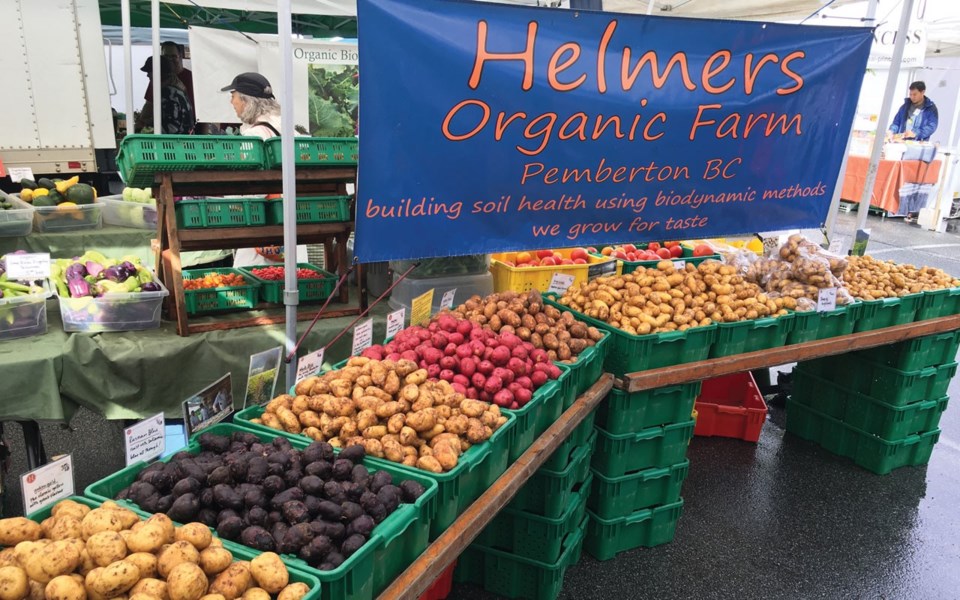Delicate and beautiful, with an earthy-tasting flesh. Rosy red skin with golden yellow flesh. A yellow one with pink eyes she calls a Robert Redford.
No, Anna Helmer isn't waxing eloquent about 17th century Romantic paintings or drafting a languid poem. She's talking about potatoes.
The Helmer family has been farming in Pemberton Valley for four generations. Potato-growing goes back to her great-grandfather in the 1940s. It's a proud tradition, one I never thought of as poetic until I spoke with Anna, who manages the family's biodynamic, organic farm. It's also a timeless tradition with roots that interconnect valley residents.
Great-grandad Helmer sold Bruce Miller's grandad his first seed potatoes back in the '40s or '50s, when "Grandpa" Miller started growing potatoes on the farm that his dad started in 1895. (The Miller farm, potatoes and all, eventually morphed into Across the Creek Organics and, more recently, The Beer Farmers, growing their own barley and hops for their own beer.) The Beks' Shaw Creek Farm also has long potato roots. It's been carrying on Pemby's illustrious potato-growing tradition since the 1950s when John Beks' dad started the farm after emigrating from Holland.
Like so many good things in life, potatoes are too easily overlooked. This seems all the more heartbreaking in Sea to Sky country, where once upon a time nearly everyone valued Pemberton for its amazing potatoes, especially seed potatoes.
"I think we have moved far away from the origins of Pemberton, no question, as a farming community, and valuing the soil and its ability to produce food. It's not just Pemberton but collectively, as a culture, we've forgotten how important that is, the ability to grow food," says Jennie Helmer, Anna's sister. A seven-year councillor for the Village of Pemberton—at least for a few more weeks—she also helps out on the family farm.
"In the 1940s, there was a seed potato lab here, there was a lot of federal funding at the time for seed potatoes, and Pemberton was identified as an isolated, virus-free growing area and was really valued for that," says Jennie. "Plus it had huge tracts of really valuable soil."
Today, 400-plus varieties of potatoes are registered in Canada. Pemberton Valley produces about 35 varieties and about nine million pounds of them annually, about 90 per cent as seed potatoes, the rest for the table. It's enough to give 90,000 people 100 pounds apiece, the average amount each Canadian eats in a year.
"The thing about potatoes," says Anna, "is that you can practically live on them. They contain just about everything you need except vitamin D—protein; carbohydrates; vitamins, minerals and fibre; and more potassium than bananas."
It was silver and gold that the Spanish conquistadores were after in the early 16th century when they marched into the Inca kingdom in the high Andes. But the real treasures they carried away, reports Henry Hobhouse in his wonderful book, Seeds of Change, were corn and potatoes.
"(The potato) became far more than a source of food," writes Mr. Hobhouse. "It became the cause of population explosion and changed the future of two European countries." England was one; the other was Ireland, whose population would explode with the "discovery" of potatoes then implode in a series of famines when they were infected by blight. It was Sir Francis Drake who'd brought the future-changing potatoes to England.
Anna, who also works in the seed potato lab that helps get those Pemby seed potatoes growing throughout North America, knows more stories that illustrate how potatoes were valued.
About the time they were spreading to Europe, potatoes also spread to the South Pacific. There, they were reserved for royalty, who wore potato blossoms in their hair because they were so precious.
In Europe, a noble landowner realized potatoes were a wonderful food despite the fact most people thought "they were kind of low-brow." He posted guards around his potato fields, and people who had previously poo-pooed the humble tuber were soon pilfering them, spreading them like crazy. They ended up with plentiful crops; the nobleman ended up with better nourished citizens.
As for those poetic potatoes Anna described earlier, they're all grown in Pemberton. There's the White Rose, with its delicate white flesh, and the Désirée with its rosy-red skin and golden flesh, perfect for making gnocchi (the starch levels are just right). And the Robert Redford? That's Anna's nickname for the Yukon Gold. Like the iconic actor, some think it's the best thing ever and can't be convinced there's another as good or better.
If you're mashing up a storm of potatoes for Thanksgiving dinner, try some Pemby GemStar Russets for white, fluffy mashed patooties that hold the gravy perfectly, or those Yukon Golds for smooth, silky, rich, yellow, mash.
But enough talk. Go cook yourself up some potatoes using these potato-growers' tips.
Jennie's faves are the amazing Sieglindes, sometimes called German butter potatoes. Eternally tasty and buttery, slice them lengthwise, toss them in salt, oil and cracked paper, then roast them in a 380-degree oven for about 45 minutes. They'll come out beautiful, crispy and delicious.
Anna's new love are Kennebecs, cut up and roasted like big fat fries. Again, toss them with olive oil, salt and pepper, and roast in a hot oven, about 400 degrees, turning them often. They should be done in 40-45 minutes, when you can easily slip a knife into them
"It's insane," says Anna. "When they come out of the oven, they look like slabs of bacon!"
Potatoes as meat. There's some kind of poetic justice in that.
Glenda Bartosh is an award-winning journalist who loved potatoes before she could walk.




